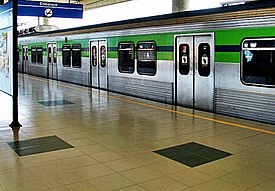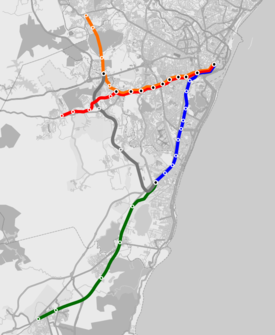Recife_Metro
Recife Metro
Rapid transit system in Recife
The Recife Metro (Portuguese: Metrô do Recife, Metrorec) is a rapid transit system serving the Metropolitan Region of Recife, Pernambuco, Brazil. It is operated by the federally-owned Companhia Brasileira de Trens Urbanos (CBTU) and currently serves 29 stations, along 39.5 kilometers (24.5 mi) of track. The system is complemented by two diesel-powered light rail lines with seven additional stations.[2] In 2018, the combined system carried 102,089,000 passengers.[3]
| Recife Metro | |||
|---|---|---|---|
 | |||
| Overview | |||
| Native name | Metrô do Recife, Metrorec | ||
| Locale | Metropolitan Region of Recife, Pernambuco, Brazil | ||
| Transit type | Rapid transit | ||
| Number of lines | 3 (plus 2 light rail lines) | ||
| Line number | C1, C2, S, VLT/Linha Diesel | ||
| Number of stations | 29[1] | ||
| Daily ridership | 225,000 (Metro only)[1] | ||
| Website | CBTU Recife | ||
| Operation | |||
| Began operation | 11 March 1985; 39 years ago (1985-03-11) | ||
| Operator(s) | Companhia Brasileira de Trens Urbanos (CBTU) | ||
| Number of vehicles | 40[1] | ||
| Train length | 4 cars[1] | ||
| Headway | 4.75–7 minutes (Center Line)[1] 16 minutes (South Line)[1] | ||
| Technical | |||
| System length | 39.5 km (24.5 mi)[1] | ||
| Track gauge | 1,600 mm (5 ft 3 in)[1] | ||
| |||
The contemporary metro, entirely aboveground, began construction in 1983, with funding from the World Bank.[4] The metro consists of the Center Line (with two branches, Center-1 and Center-2) and the South Line, which all radiate outward from Recife station.
The stations were designed to include various non-written means of identification, as the Northeast Region has a substantial rate of illiteracy (13.9% as of 2019).[5] In addition to audio messages announcing the name of the stop, there are visual cues: a different color is used on the walls of every station, and stations are uniquely identified with pictograms, similar to the Mexico City Metro.
Center Line trains leaving Recife station have one of two destinations: Center-1 trains run to Camaragibe, while Center-2 trains serve Jaboatão dos Guararapes. The two branches run on the same tracks between Recife station and Coqueiral station, reusing the route of an old railway track, where the metro system was built. The South line runs from Recife station parallel to the shore of the Atlantic.
The average distance between stations is of 1.2 kilometers (0.7 mi) so the typical speed of the train is 40 km/h (25 mph), but the maximum speed is 90 km/h (56 mph).[1] The gauge is 1,600 mm (5 ft 3 in) (Irish gauge) and the trains are powered by overhead lines.[1]
The system originally had a total of 25.2 kilometers (15.7 mi) of route. After completion of the expansion of the network that occurred from February 2005 to March 2009, the metro grew to its current 39.5 kilometers (24.5 mi) in length.[1]
Diesel light rail
A 31.5 km (19.6 mi) long meter gauge (1,000 mm (3 ft 3+3⁄8 in)) light rail network (Brazilian Portuguese: Veículo Leve sobre Trilhos, VLT) is integrated with the metro system.[1] Two light rail lines link the city of Cabo de Santo Agostinho with Recife and provide a connection between the Center-1 and South lines through the suburbs. The rail lines are not electrified, and use diesel vehicles. Terminology varies, with the CBTU and media referring to it both as the VLT and as the Linha Diesel ('Diesel line'), the name of the former heavy rail service.[6][7][8]
Bus integration
The system also includes several bus lines linked from the terminals of bus/metro integration designated SEI (Sistema Estrutural Integrado - "Integrated Structural System") through which passengers may continue their travel on the same ticket.[9]
Metro
The metro is built to a gauge of 1,600 mm (5 ft 3 in), (Irish gauge). All three lines are elevated or at grade, and trains are powered by overhead lines.
| Line | Terminals | Start date | Length | Stations | Duration (min) | Schedule (as of April 2021)[10] |
|---|---|---|---|---|---|---|
| Center - 1 | Recife ↔ Camaragibe | 11 March 1985 | † | 15 | 28 | Daily, 5 AM to 11 PM |
| Center - 2 | Recife ↔ Jaboatão | 29 August 1987 | † | 14 | 24 | Daily, 5 AM to 11 PM |
| South | Recife ↔ Cajueiro Seco | 28 February 2005 | 14.3 km | 13 | 25[11] | Daily, 5 AM to 11 PM |
| Total (metro system) | 39.5 km[1] | 29[1] | --- | --- | ||
† Center-1 and Center-2 lines share a significant amount of track. The precise length of each branch has not been published.
Light rail
Metre gauge (1,000 mm (3 ft 3+3⁄8 in) is used, in common with most other railways in Brazil. It is built at grade.
| Line | Terminals | Start date | Length | Stations | Duration (min) | Schedule (as of April 2021) |
|---|---|---|---|---|---|---|
| Diesel light rail (VLT) | Cabo de Santo Agustinho ↔ Cajueiro Seco, Curado ↔ Cajueiro Seco | 2012 | 31.5 km[1] | 8[1] | 54 | Monday to Friday, 5 AM to 8:44 PM
(on Saturdays, until 2pm). No service on Sunday.[10] |
| Train model[12] | Type | Years active | Country of origin | Lines served |
|---|---|---|---|---|
| ALCO RS-8 | Diesel-electric locomotive | 1959-unknown | USA | Light rail |
| CAF 100 | Electric multiple unit | 2012–present | Brazil/Spain | Metro, unknown |
| TUDH BS Mobile 3 [pt] | Diesel multiple unit | 2012–present | Brazil/Germany | Light rail |
| TUE Santa Matilde/MAN Série 800 [pt] | Electric multiple unit | 1985-unknown | Brazil/Germany/UK | Metro, unknown |
- TUE Série 800
- CAF 100
- TUDH BS Mobile 3, on a different system in Maceio
- Locomotive at Cajueiro Seco station, in 2011
Recife Metro | |||||||||||||||||||||||||||||||||||||||||||||||||||||||||||||||||||||||||||||||||||||||||||||||||||||||||||||||||||||||||||||||||||||||||||||||||||||
|---|---|---|---|---|---|---|---|---|---|---|---|---|---|---|---|---|---|---|---|---|---|---|---|---|---|---|---|---|---|---|---|---|---|---|---|---|---|---|---|---|---|---|---|---|---|---|---|---|---|---|---|---|---|---|---|---|---|---|---|---|---|---|---|---|---|---|---|---|---|---|---|---|---|---|---|---|---|---|---|---|---|---|---|---|---|---|---|---|---|---|---|---|---|---|---|---|---|---|---|---|---|---|---|---|---|---|---|---|---|---|---|---|---|---|---|---|---|---|---|---|---|---|---|---|---|---|---|---|---|---|---|---|---|---|---|---|---|---|---|---|---|---|---|---|---|---|---|---|---|
| |||||||||||||||||||||||||||||||||||||||||||||||||||||||||||||||||||||||||||||||||||||||||||||||||||||||||||||||||||||||||||||||||||||||||||||||||||||
Legend | |||||||||||||||||||||||||||||||||||||||||||||||||||||||||||||||||||||||||||||||||||||||||||||||||||||||||||||||||||||||||||||||||||||||||||||||||||||
| |||||||||||||||||||||||||||||||||||||||||||||||||||||||||||||||||||||||||||||||||||||||||||||||||||||||||||||||||||||||||||||||||||||||||||||||||||||
| Nº | Center-1 | Center-2 | South Line | Diesel Light Rail |
|---|---|---|---|---|
| 1 | Recife SEI | Recife SEI | Recife SEI | Curado C1 |
| 2 | Joana Bezerra¹ SEI | Joana Bezerra¹ SEI | Joana Bezerra¹ SEI | Jorge Lins |
| 3 | Afogados SEI | Afogados SEI | Largo da Paz SEI | Marcos Freire |
| 4 | Ipiranga | Ipiranga | Imbiribeira | Cajueiro Seco SEI, S |
| 5 | Mangueira | Mangueira | Antonio Falcão | Ângelo de Souza |
| 6 | Santa Luzia SEI | Santa Luzia SEI | Shopping Center Recife | Pontezinha |
| 7 | Edgar Werneck | Edgar Werneck | Tancredo Neves SEI | Ponte dos Carvalhos |
| 8 | Barro SEI | Barro SEI | Aeroporto - Airport SEI | Santo Inácio |
| 9 | Tejipió | Tejipió | Porta Larga | Cabo SEI |
| 10 | Coqueiral² | Coqueiral² | Monte dos Guararapes | |
| 11 | Alto do Céu | Cavaleiro SEI | Prazeres SEI | |
| 12 | Curado LRT | Floriano | Cajueiro Seco SEI, LRT | |
| 13 | Rodoviária-Coach station | Engenho Velho | ||
| 14 | Cosme e Damião | Jaboatão | ||
| 15 | Camaragibe SEI |
Notes
- SEI: integration with local buses
- 1: Center-1, Center-2 and South lines run together between Recife and Joana Bezerra stations
- 2: Center-1 and Center-2 run together between Recife and Coqueiral stations
- Examples of station pictograms
- Pictogram for Recife station, depicting the former central railway station
- "Características - Características Técnicas E Operacionais Do Metrô" [Characteristics - Technical and Operational Characteristics of Metro] (in Portuguese). CBTU-STU Recife. Archived from the original on 10 November 2014. Retrieved 15 June 2014.
- "Portal CBTU - Recife". www.cbtu.gov.br. Retrieved 5 April 2021.
- Relatório de Gestão 2018 (PDF). Companhia Brasileira de Trens Urbanos- (CBTU). 2019. p. 37.
- Oliveira de Andrade, Maurício (2009). "The Recife Metro – The Impact on Urban Development after 20 years". Flux. https://www.cairn-int.info/journal-flux1-2009-1-page-57.htm: 57–68 – via cairn.info.
{{cite journal}}: External link in|volume= - "Continuous National Household Sample Survey - Continuous PNAD 2019". IBGE. Retrieved 6 April 2021.
- Pernambuco, Diario de (14 December 2020). "CBTU altera horários de VLTs da Linha Diesel". Diário de Pernambuco (in Brazilian Portuguese). Retrieved 6 April 2021.
- "Linha Diesel do Metrô do Recife anuncia retomada da operação anterior à pandemia e ganha novos horários". G1 (in Brazilian Portuguese). Retrieved 6 April 2021.
- "Conselho da CBTU veta adiar aumento da tarifa do metrô no Recife". G1 (in Brazilian Portuguese). Retrieved 6 April 2021.
- "Sistema Recife". Archived from the original on 2 February 2008. Retrieved 17 July 2009.
- "Portal CBTU - horários". www.cbtu.gov.br. Retrieved 6 April 2021.
- "Sitio da Superintendencia de Trens Urbanos do Recife". Archived from the original on 15 July 2009. Retrieved 15 July 2009.
- "Frota de TUEs é 2,97% maior que ano passado" (PDF). Revista Ferroviária. October 2017.
- CBTU Recife – official website (in Portuguese)
- Parent company CBTU's website; Contains links to other Brazilian urban rail systems
- Photographic gallery for the Diesel line (pictures taken at a "photographical excursion" involving several photo artists at 19 August 2009)
